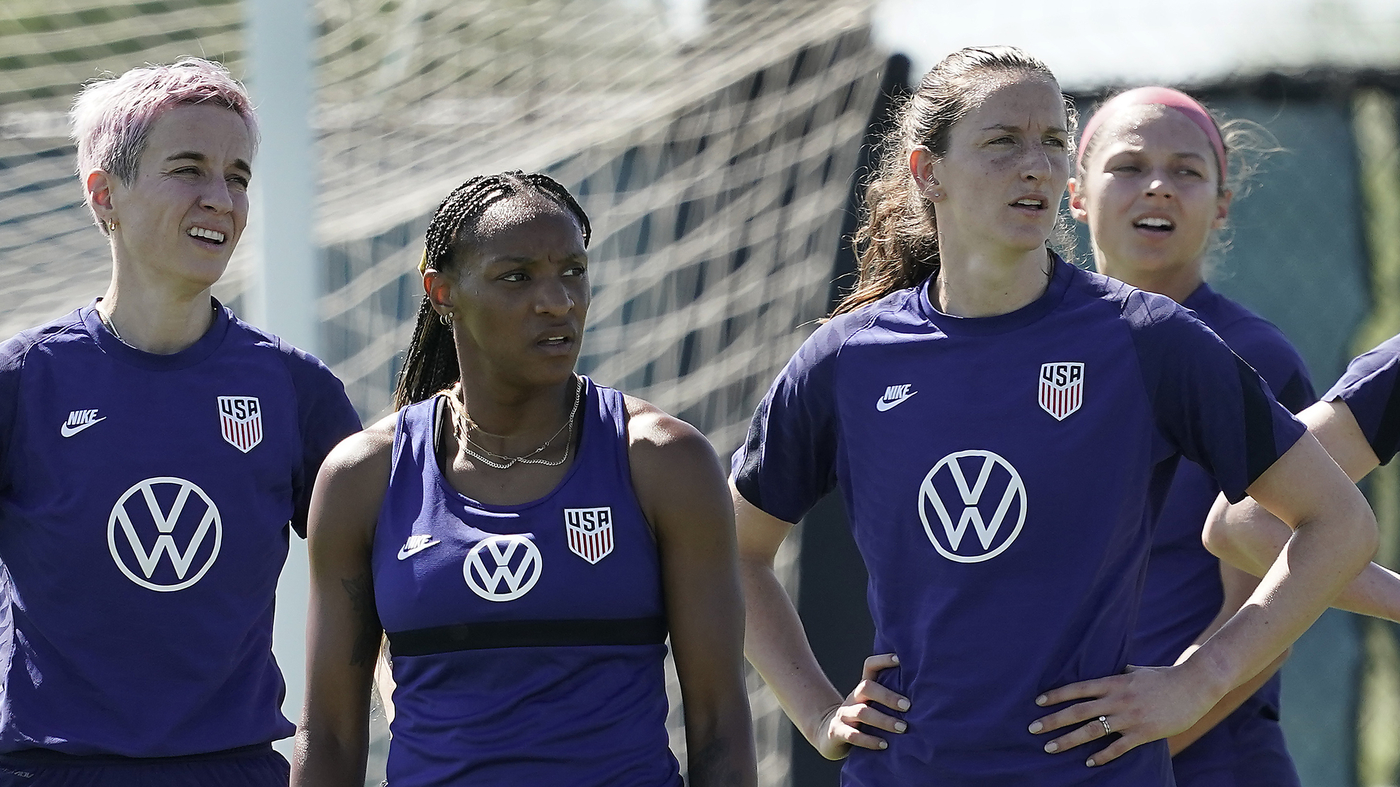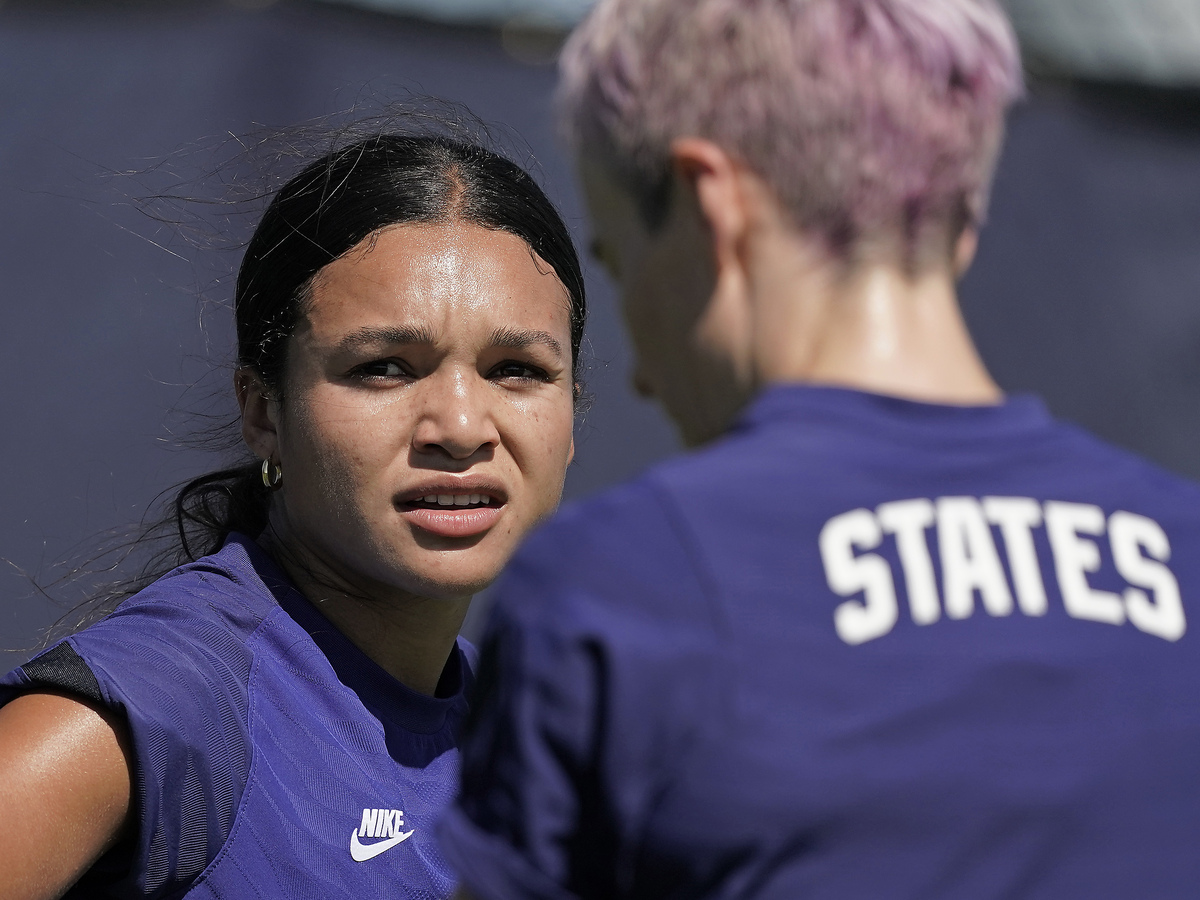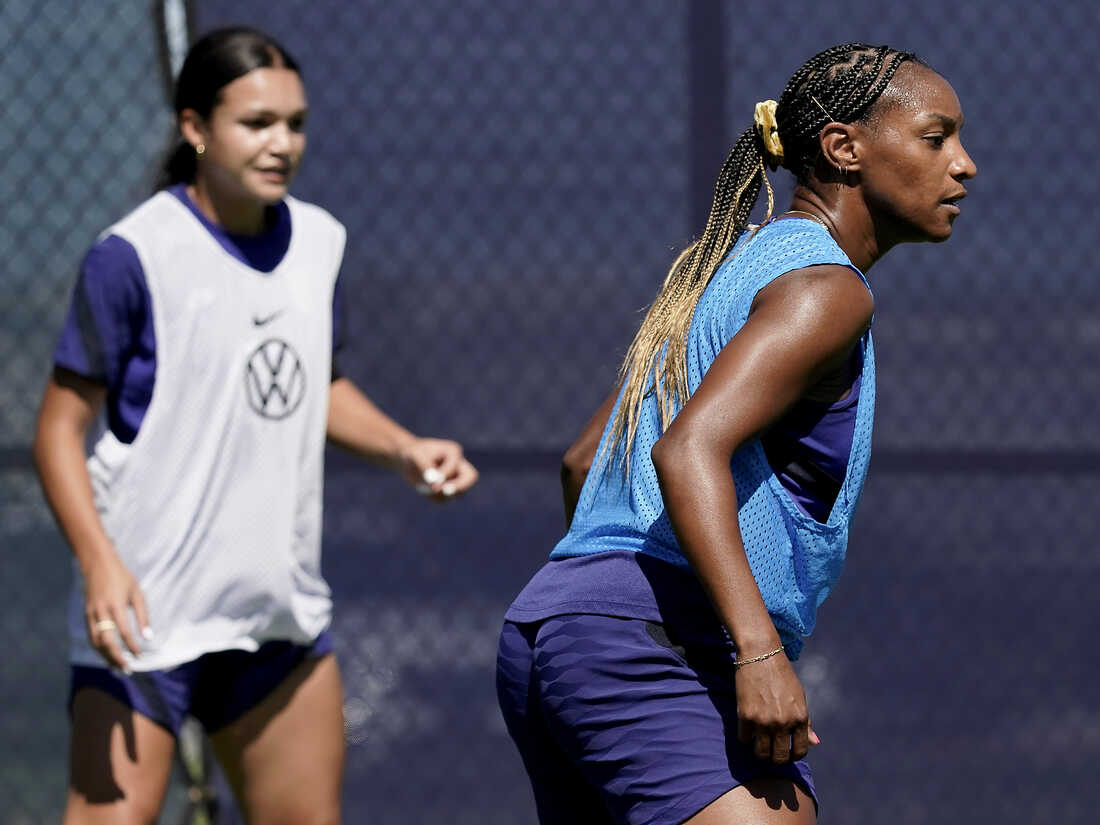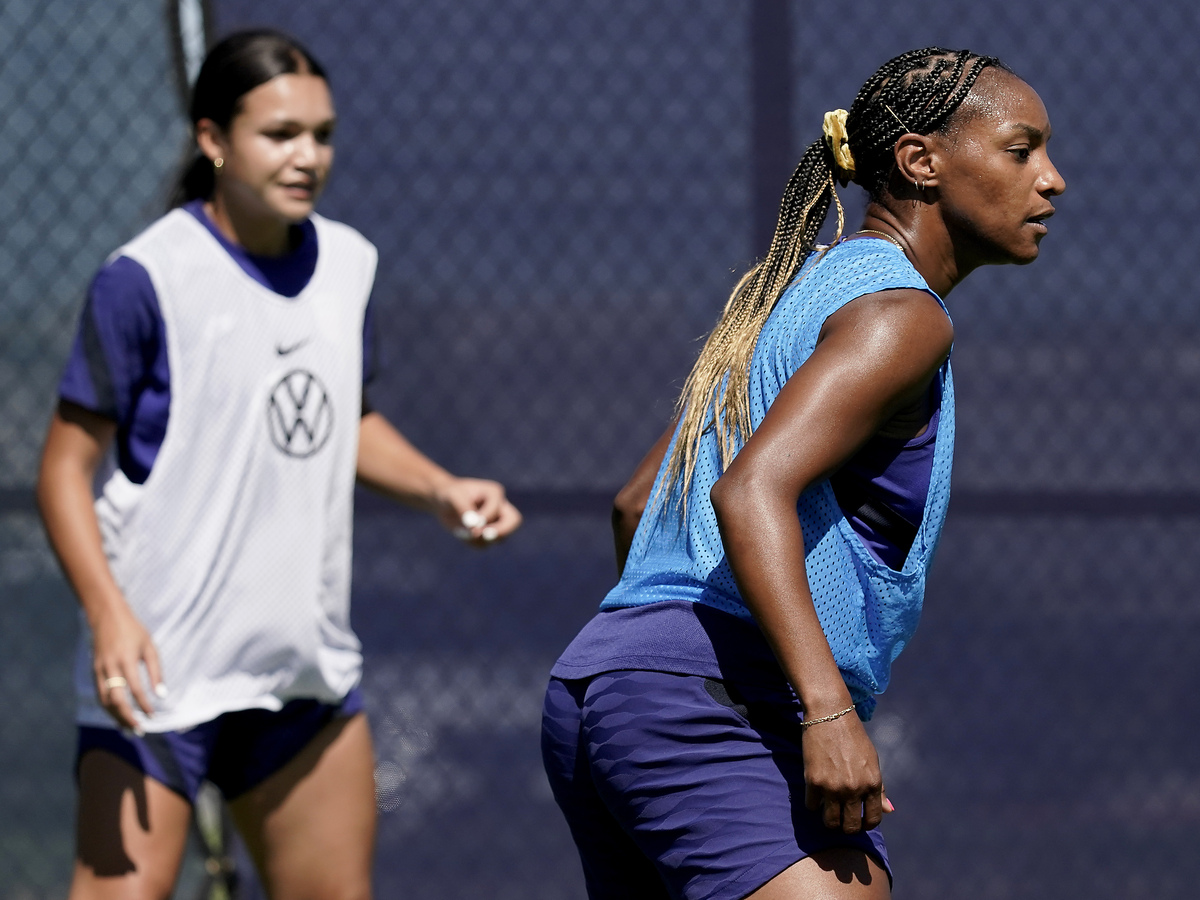

USA National Team player Crystal Dunn, second from left, listens to instructions with teammates during practice for a match against Nigeria on Tuesday, August 30, 2022 in Riverside, Mo.
Charlie Riedel/AP
hide caption
toggle subtitle
Charlie Riedel/AP

USA National Team player Crystal Dunn, second from left, listens to instructions with teammates during practice for a match against Nigeria on Tuesday, August 30, 2022 in Riverside, Mo.
Charlie Riedel/AP
PORTLAND, Ore. — Crystal Dunn used to be the only black girl on her youth soccer clubs, and even when she finally made the national team, she did her own hair and makeup for photo shoots because “there wasn’t anybody set up for me.”
While the US team has become increasingly representative, Dunn says there is still work to be done. This starts with ensuring that young black women feel included down to the youth level.
“I had very supportive parents who explained to me, ‘It’s okay, you’re still welcome in this sport. And just because there aren’t many people who look like you, this is still your game,'” Dunn said. This support was key to their success “because honestly, at the end of the day, it’s pretty lonely feeling like you’re the only one in this space and not feeling like you belong.”
Women’s soccer in the United States has long had a diversity problem: The sport’s pay-to-play model means it’s expensive, especially at higher levels. Club teams and traveling teams can cost thousands of dollars in some cases. Almost from the beginning, players without financial resources — many of them from marginalized communities — are left behind.
Even US Soccer President Cindy Parlow Cone lamented that American football is seen as a “rich white kid’s sport”.
Dunn first played for the national team in 2013 and was part of the squad that won the 2019 World Cup in France. The job also involved off-field duties, such as participating in professional photo shoots and public appearances.
These events often included hair and makeup assistance for white players, but with no guarantee that the stylists would know how to work with black skin or black hair.
“These are things that a lot of people never had to think about because there weren’t a lot of us,” Dunn said.
She was among just five black players out of 23 on the World Cup winning team’s roster. In contrast, France had 12.

U.S. National Team player Sophia Smith listens to instructions during practice for a match against Nigeria on Tuesday, August 30, 2022 in Riverside, Mo. Women’s soccer in the United States has struggled with diversity, starting with a pay-to-play model that can exclude talented kids from communities of color.
Charlie Riedel/AP
hide caption
toggle subtitle
Charlie Riedel/AP

U.S. National Team player Sophia Smith listens to instructions during practice for a match against Nigeria on Tuesday, August 30, 2022 in Riverside, Mo. Women’s soccer in the United States has struggled with diversity, starting with a pay-to-play model that can exclude talented kids from communities of color.
Charlie Riedel/AP
The most recent U.S. roster had 10 women of color — including young stars Trinity Rodman, Naomi Girma and Mallory (Pugh) Swanson — as the team geared up for this summer’s World Cup. The United States will face New Zealand twice next week as the teams prepare for the tournament, which will be co-hosted by Australia and New Zealand.
“Representation is important,” said Sophia Smith, who scored 11 goals for Team USA last year and won the American Football Player of the Year award. “And I think girls can look at the screen or go to a game and see a lot of different looking people, it’s great.”
The increased representation helped diversify a team that included fewer than a dozen black players in its entire history prior to 2012.
The pool of players talented enough for every highest level in America – the national team and the National Women’s Soccer League – is already small. The exclusionary nature of youth football makes it even smaller.
The pay-to-play structure “leaves many marginalized minority communities in the lurch” because of high costs, Dunn said. “And if I didn’t have parents who could hand out three, four, or five thousand a year, I don’t know if I can sit here and say that I would have continued to play this sport.”
Parlow Cone told a youth sports panel last year that the US federation is looking into access to the game.
“A lot of it comes down to how our sport is viewed, marketing and how do we change this thinking that it’s a rich white kids sport to a sport that is literally played in every country in the world?” she said. “And as the most diverse country in the world here in the US, how do we shift that focus to making sure every child feels welcome in our game?”
Ed Foster-Simeon, CEO of the US Soccer Foundation, is among those trying to make soccer more accessible to communities that traditionally have not been involved.
The foundation’s Soccer for Success program has worked with more than 400,000 children – 90% of them from black communities – since 2008. The program expects to reach more than 100,000 children this year.
The foundation says more than 121,000 girls from underserved communities have benefited from its programs over the past three years – part of its United For Girls initiative launched after the 2019 World Cup. Additionally, the foundation has hired 5,475 female-identified coaches or non-binary during this period.
The foundation’s goal is not to develop elite talent, but to bring the game to more kids, particularly those in less-resourced communities, he said.
In recent years, “clearer and clearer paths” have emerged for talented young people, Foster-Simeon said. “But I think our biggest challenge even today is that we’re just scratching the surface in terms of participation. We’re not reaching enough kids.”
Indeed, much of the work with girls is being done at the grassroots level.
Shannon Boxx, who was inducted into the National Soccer Hall of Fame last year, played on the national team from 2003 to 2015. She is on the board of Bridge City Soccer in Portland – which aims to bring girls into the game.
She remembers moments at the selection when she realized she was the only person of color present.
“For me, it was just a big weight that I was willing to carry, but I remember feeling like, OK, when we’re signing autographs, I’m looking for those kids who are black because I want them to know that they can do this.” , she said. “And I may be the one now, but it won’t be like that in the future.”
Shawna Gordon, a former pro who played for Sky Blue (now Gotham FC) in the National Women’s Soccer League, started the nonprofit Football For Her in Southern California to mentor young players on and off the field – regardless of socioeconomic status. . Football For Her takes a whole person approach, addressing nutrition and mental health as well as playing skills.
“It’s a challenge to play with tough players, as if everyone is talented in their own way. And for me, that helps me find my why,” said Amber Ramirez, 13, who attended a Friday night at Soccer For Her program last fall.
There is evidence that these efforts may be working. Ten years ago, only 24% of top flight women’s soccer players were non-white. The number grew to 34% last season.
But many believe that palliative measures are not the answer. They want to reconsider the pay-to-play model.
The pay-to-play model “is completely endemic to the problems we’re having, so how do we try to tweak it?” said Kate Markgraf, general manager of Women’s USA. “I think we’ve finally reached a point where we’re willing – not as football, but as a society – our eyes are open in a way they’ve never been.”
Dunn is hopeful. When she joined the national team, there were far fewer women of color in the sport and even fewer playing at the highest levels.
It’s important to celebrate progress, she said, “but it’s also important to keep pushing, pushing for more, and pushing for more women of color to be able to access the sport.”

US National Team players Crystal Dunn, right, and Sophie Smith train for a match against Nigeria on Tuesday, August 30, 2022, in Riverside, Mo.
Charlie Riedel/AP
hide caption
toggle subtitle
Charlie Riedel/AP

US National Team players Crystal Dunn, right, and Sophie Smith train for a match against Nigeria on Tuesday, August 30, 2022, in Riverside, Mo.
Charlie Riedel/AP




Comments
Post a Comment